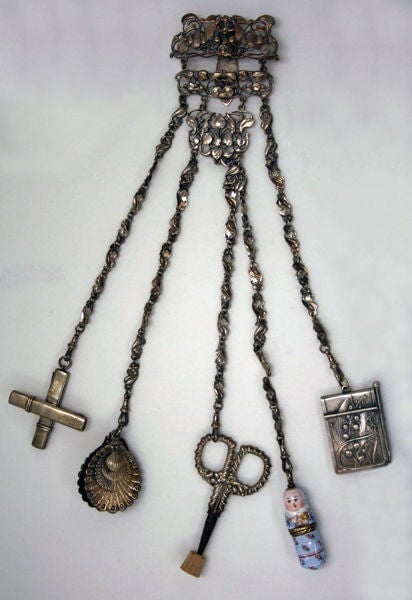Fanny packs are one of humankind’s oldest accessories
Fanny packs are back in fashion—so much so that they accounted for nearly a quarter of the US accessories industry’s growth in the first 10 months of 2018. These days, we call them “waist bags” or “belt bags.” The unfortunate moniker “fanny pack” (or in the UK, “bum bag”) just doesn’t have a luxurious connotation, and today’s iterations can indeed be luxurious.


Fanny packs are back in fashion—so much so that they accounted for nearly a quarter of the US accessories industry’s growth in the first 10 months of 2018. These days, we call them “waist bags” or “belt bags.” The unfortunate moniker “fanny pack” (or in the UK, “bum bag”) just doesn’t have a luxurious connotation, and today’s iterations can indeed be luxurious.
It’s tempting to write the current trend off as a silly throwback to the 1980s, when the fanny pack enjoyed its neon-hued heyday. But this view of the accessory is myopic. There is perhaps no better reminder that the particular moment we inhabit is but a blip in the epic sweep of human history than the fanny pack.
1991 is an important year in this story, but not for the reason you may think. The nylon atrocity that had swept fashion in the 1980s with the first wave of athleisure (sweat pants and tracksuits as fashion) was already beginning its decline. After more or less peaking in 1988, the year Adweek named the fanny pack the hottest product on the market, a proliferation of tacky logo-adorned iterations had cheapened what was once a straightforward functional accessory. The fanny pack was slipping out of style.
But that’s also the year that, high in the mountains along the Italian-Austrian border, a pair of German tourists stumbled across a frozen corpse. At first, rescuers assumed they’d recovered the body of an unfortunate hiker. They weren’t wrong, but this particular hiker had lain there for roughly 5,000 years. The mummy, who became an international celebrity called Otzi the Iceman, was astonishingly well-preserved, right down to his accessories, which included a calfskin belt affixed with a pouch containing handy items such as “tinder fungus, a scraper, a boring tool, a bone awl, and a flint flake.”

Belt bags are nothing if not practical, which explains why they were already in use in the Copper Age. In fact, hip-hugging bags appear in some form in every culture through the ages, according to Racked. Ancient Egyptian hieroglyphics depict men wearing bags on belts. Since togas lacked pockets, Ancient Romans attached coin purses to their arms or belts. Ditto kimonos: in 17th century Japan pouches, baskets, or boxes called “inro” were attached to the robes with cords called “netsuke.” Native Americans crafted beaded buffalo hide pouches and medieval European Christians carried daily necessities and coins for the poor in alms purses.
“The concept of waist-hung items is almost universal across all cultures,” Genevieve Cummins told Collector’s Weekly. This really took off in the Victorian era, according to Cummins who wrote a book about chatelaines, a popular 18th century device that attached an assortment of handy objects to a woman’s dress like an elaborate key ring. Worn by women at all levels of society, chatelaines functioned “like a customized Swiss Army knife.” Seamstresses would carry stitching tools, nurses medical equipment, and royal ladies luxury status items such as watches and fans. Women customized them for their hobbies or life stage, from nursing to mourning.

In the 1950s, the British coined the slang term “bum-bag” to refer to the pouch worn on ski slopes. This soon morphed to “fanny pack” in the US and took on a more universally sporty aspect. A 1954 Sports Illustrated gift guide touts a fanny pack “designed to hold a cross-country skier’s wax and lunch” but “also useful for cyclists, hikers, equestrians.”
It’s this piece of practical sportswear that rose to neon nylon ubiquity in the 1980s, as everyday athletic wear and tourism both surged. For a time the fanny pack was at home equally on runways and on the everyman at rest. But from this high point, the fanny pack seemed, from our vantage point anyway, to recede into the annals of unfortunate fashion history. It became a pop culture punchline.
But the fact that carrying stuff around your waist was practical never changed. Skateboarders didn’t forget it; the “skater bag,” essentially a fanny pack, but more commonly worn slung across the shoulders, was in production before the 1990s were out, with the influential brand Supreme producing one early in its rise to streetwear dominance.
And in truth the fanny pack never really went extinct; it merely morphed and shifted in symbolism for a decade or so, until it started percolating, as many streetwear staples did, up the fashion food chain. It began showing up on the runways of luxe designers, including Balenciaga and Louis Vuitton, circa AD 2014.
Perhaps not coincidentally, according to some accounts, that’s also the year that Dwayne “The Rock” Johnson started the “Fanny Pack Rock” meme, by posting a throwback photo on Instagram. The rest, as they say, is history.